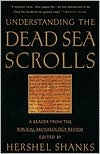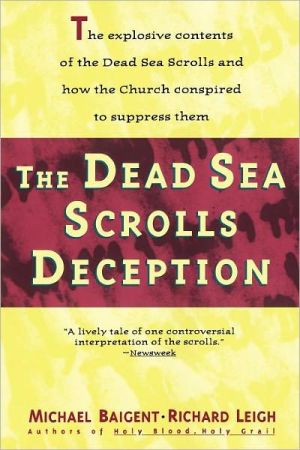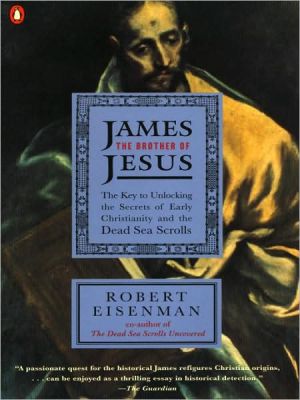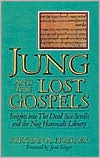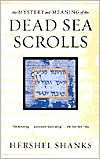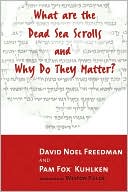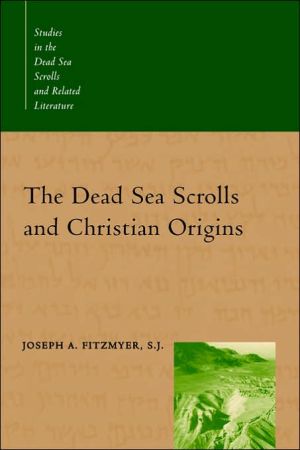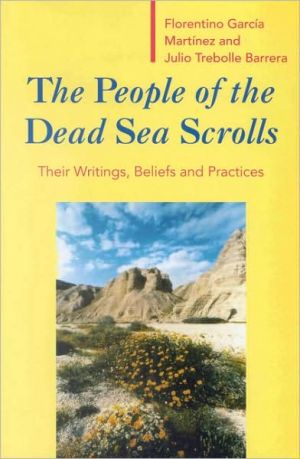Understanding the Dead Sea Scrolls: A Reader from the Biblical Archaeology Review
A groundbreaking anthology that demolishes the myths -- and reveals the true significance -- of the greatest archaeological discovery of our time.\ Ever since their initial discovery in 1947, the Dead Sea Scrolls have aroused excitement, jealousy, and not a little dread among some who feared their contents might undermine the foundations of Judaism and Christianity. For more than 35 years the majority of scroll texts remained the intellectual property of an exclusive coterie of scholars....
Search in google:
A groundbreaking anthology that demolishes the myths — and reveals the true significance — of the greatest archaeological discovery of our time.Ever since their initial discovery in 1947, the Dead Sea Scrolls have aroused excitement, jealousy, and not a little dread among some who feared their contents might undermine the foundations of Judaism and Christianity. For more than 35 years the majority of scroll texts remained the intellectual property of an exclusive coterie of scholars. Recently, however, the Biblical Archaeology Review succeeded in breaking that monopoly.This path-clearing volume is an illuminating assessment of what these texts reveal about a lost era in the history of two world religions, Christianity and rabbinic Judaism. Were the Dead Sea Scrolls written by the Essenes, an ascetic sect of Jews that may have included John the Baptist among its members? Is the Copper Scroll a secret map to the treasures of the Jerusalem Temple? In what way do these books prefigure the teachings of early Christianity? Additional chapters address the controversies surrounding the Scrolls' discovery and their long suppression — including the possible role of the Vatican and charges of anti-Semitism on the part of a former chief editor of the official scroll publication team. Publishers Weekly Culled from the pages of Biblical Archaeology Review , edited by Shanks, these essays by scholars in the field shed further light on the Dead Sea Scrolls, which were discovered in the Qumran caves east of Jerusalem in 1947. Eschewing the mainstream opinion that identifies the inhabitants of Qumran as members of a Jewish religious sect called the Essenes, Lawrence Schiffman radically links the sectarians with the priestly and scripturally literalistic Sadducees. The late Yigael Yadin describes his laborious efforts to acquire the crucial Temple Scroll, the difficult task of unrolling it and his belief that Jesus was anti-Essene even though the Essenes' rejection of the Jerusalem Temple and its cult influenced the early Christians. Hartmut Stegemann claims that the Temple Scroll is a lost sixth book of the Torah composed of material rejected when the Pentateuch was canonized under the influence of Ezra in the fifth century B.C. In a 1990 interview with an Israeli journalist, John Strugnell expresses anti-Semitic views; he was subsequently removed from his position as chief Scrolls editor. Illustrations not seen by PW. (July)
Of Caves and Scholars: An OverviewIThe Find1Discovering the Scrolls32The Historical Context of the Scrolls20IIWhere They Came From3The Sadducean Origins of the Dead Sea Scroll Sect354The People of the Dead Sea Scrolls: Essenes Or Sadducees?505"First Dead Sea Scroll" Found in Egypt Fifty Years Before Qumran Discoveries636Essene Origins--Palestine Or Babylonia?79IIIThe Temple Scroll7The Temple Scroll--The Longest Dead Sea Scroll878The Gigantic Dimensions of the Visionary Temple in the Temple Scroll1139Intrigue and the Scroll11610Is the Temple Scroll a Sixth Book of the Torah--Lost for 2,500 Years?126IVThe Dead Sea Scrolls and the Bible11The Text Behind the Text of the Hebrew Bible13912Light on the Bible from the Dead Sea Caves15613When the Sons of God Cavorted With the Daughters of Men167VThe Dead Sea Scrolls and Christianity14The Dead Sea Scrolls and Christianity18115An Unpublished Dead Sea Scroll Text Parallels Luke's Infancy Narrative20316Was John the Baptist an Essene?205VIThe Dead Sea Scrolls and Rabbinic Judaism17New Light on the Pharisees217VIIThe Copper Scroll18The Mystery of the Copper Scroll227VIIIReconstructing the Scrolls19How to Connect Dead Sea Scroll Fragments245IXControversy and the Scrolls20Interview With Chief Scroll Editor John Strugnell25921Silence, Anti-Semitism, and the Scrolls26422Is the Vatican Suppressing the Dead Sea Scrolls?275Notes291About the Authors313Index317
\ Publishers Weekly\ - Publisher's Weekly\ Culled from the pages of Biblical Archaeology Review , edited by Shanks, these essays by scholars in the field shed further light on the Dead Sea Scrolls, which were discovered in the Qumran caves east of Jerusalem in 1947. Eschewing the mainstream opinion that identifies the inhabitants of Qumran as members of a Jewish religious sect called the Essenes, Lawrence Schiffman radically links the sectarians with the priestly and scripturally literalistic Sadducees. The late Yigael Yadin describes his laborious efforts to acquire the crucial Temple Scroll, the difficult task of unrolling it and his belief that Jesus was anti-Essene even though the Essenes' rejection of the Jerusalem Temple and its cult influenced the early Christians. Hartmut Stegemann claims that the Temple Scroll is a lost sixth book of the Torah composed of material rejected when the Pentateuch was canonized under the influence of Ezra in the fifth century B.C. In a 1990 interview with an Israeli journalist, John Strugnell expresses anti-Semitic views; he was subsequently removed from his position as chief Scrolls editor. Illustrations not seen by PW. (July)\ \ \ \ \ Library JournalThe discovery and publication of the Dead Sea Scrolls is one of the most important and controversial events in 20th-century biblical and related studies. As editor and publisher of Biblical Archaeology Review (BAR), Shanks has observed the progress of Scroll studies and the heat they have generated. Here, he compiles 22 articles from the pages of BAR and Bible Review dealing with the discovery of the Scrolls, the ancient community that stored them away, and their impact upon the study of the Bible, Rabbinic Judaism, and early Christianity. Three chapters on the controversy surrounding the publication (and in many cases nonpublication) of the materials round out the volume. In the final chapter, Shanks reacts to the recent sensational book The Dead Sea Scrolls Deception ( LJ 1/92), labeling as ``hogwash'' their charge of Vatican suppression of Qumran material and interpretations that might undermine Church doctrine. The articles included are written by scholars but are easily accessible to lay readers. Coverage is balanced, including opposing viewpoints. There is one annoying omission: nowhere in the volume are the original publication dates of the articles given. This anthology is appropriate for public and academic libraries.-- Craig W. Beard, Univ. of Alabama at Birmingham\ \
